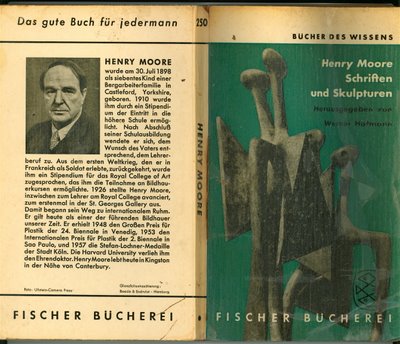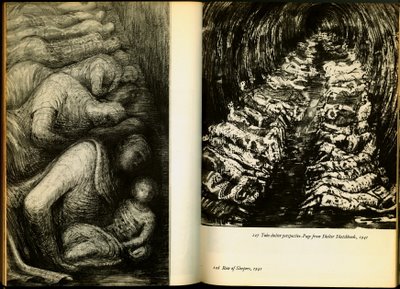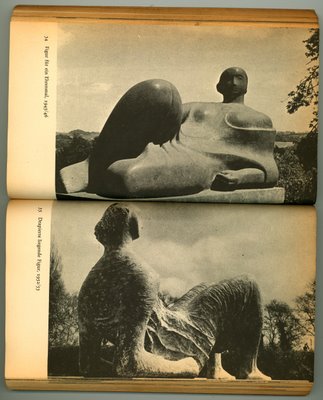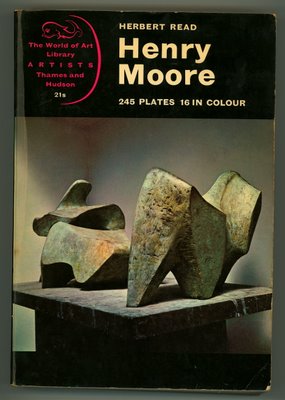*
HENRY MOORE
I wish I had met him.
2006
bp
HENRY MOORE
I wish I had met him.
2006
bp
*

In 1964 kocht ik mijn eerste boekje met werk van- en over Henry Moore. Het was een pocket uitgave uit 1959 van de Fischer Buecherei KG. In het Duits, dus echt gelezen heb ik het nooit want vreemde talen zijn nooit mijn sterkste kant geweest. Maar de plaatjes heb ik verslonden! Ik ben opgegroeid in een periode waarin conceptuele kunst, zeker in Nederland nog in de kinderschoenen stond. We hadden DaDa gehad en ZERO en Fluxus waren bezig zich te bewijzen. Een moeilijke periode voor een aankomend kunstenaar. We verslonden tentoonstellingen bij de vleet, maar zelf bleef ik bezig met het pure handwerk en aardse materialen waarmee ik probeerde VORM te maken. Alles draaide om vorm, er moest spanning in zitten, maar ook inhoud hebben. Moore maakte beelden waarin ik dat alles terug vond, dus keek ik goed naar zijn werk. In 1966 kreeg ik met kerst van Marion het tweede boek, iets groter en een ietsje meer kleurplaten. Belangrijker was dat er meer recent werk in stond. De zeer grote twee- en drie delige Reclining Figures. Maar ook betere reproducties van de tekeningen uit het Shelter Sketchbook. Die tekeningen zijn echte beeldhouwers tekeningen, de verbeelding van massa en vorm. Ze zijn nog steeds schitterend om te zien.
In 1964 I bought my first book on the work of Henry Moore. It was a paperback from 1959, from the Fischer Buecherei KG. In German, so I've never really read it, since foreign languages have never been my strong point. But I devoured the pictures! I grew up in the period when conceptual art was still in its infancy, certainly in the Netherlands. We had had DaDa, and ZERO and Fluxus were busy establishing themselves. It was a difficult period for an artist in the making. We devoured heaps of exhibitions, but I personally stuck to pure handwork and earthbound materials, with which I tried to create FORM. Form was what it was all about, it had to have tension, but content too. Moore made sculptures which had all of that, so I studied his work well. In 1966 Marion gave me the second book for Christmas, a bit bigger and with a few more colour plates. More importantly, it contained recent work: the very large two and three-part Reclining Figures, but also better reproductions of the drawings from the Shelter Sketchbook. The drawings are real sculptor's drawings, the depiction of mass and form. They are still wonderful to see.


Zijn vrouwen figuren stralen kracht en standvastigheid uit, erotiek is ver te zoeken. Behalve misschien in dit beeld. Hij noemt het 'Three Points', het is zeer suggestief. Voor mij bedekte erotiek uit het begin van de 40er jaren. Misschien heb ik het helemaal mis en had hij er een politieke bedoeling mee.
His women radiate strength and steadfastness, there's no hint of the erotic there. Except perhaps for this sculpture. He calls it 'Three Points', it's very suggestive. To me, it represents covert eroticism from the early forties. Though maybe I've got it completely wrong and he was making a political point.



In 1964 I bought my first book on the work of Henry Moore. It was a paperback from 1959, from the Fischer Buecherei KG. In German, so I've never really read it, since foreign languages have never been my strong point. But I devoured the pictures! I grew up in the period when conceptual art was still in its infancy, certainly in the Netherlands. We had had DaDa, and ZERO and Fluxus were busy establishing themselves. It was a difficult period for an artist in the making. We devoured heaps of exhibitions, but I personally stuck to pure handwork and earthbound materials, with which I tried to create FORM. Form was what it was all about, it had to have tension, but content too. Moore made sculptures which had all of that, so I studied his work well. In 1966 Marion gave me the second book for Christmas, a bit bigger and with a few more colour plates. More importantly, it contained recent work: the very large two and three-part Reclining Figures, but also better reproductions of the drawings from the Shelter Sketchbook. The drawings are real sculptor's drawings, the depiction of mass and form. They are still wonderful to see.


Zijn vrouwen figuren stralen kracht en standvastigheid uit, erotiek is ver te zoeken. Behalve misschien in dit beeld. Hij noemt het 'Three Points', het is zeer suggestief. Voor mij bedekte erotiek uit het begin van de 40er jaren. Misschien heb ik het helemaal mis en had hij er een politieke bedoeling mee.
His women radiate strength and steadfastness, there's no hint of the erotic there. Except perhaps for this sculpture. He calls it 'Three Points', it's very suggestive. To me, it represents covert eroticism from the early forties. Though maybe I've got it completely wrong and he was making a political point.


Echt leuk en leerzaam worden voor mij kunstenaars boeken pas als ze laten zien hoe er gewerkt wordt. Hoe een beeld tot stand komt, hoe het letterlijk ontstaat, opgebouwd wordt. De ontwerpen voor dit beeld, 'Three-Way Piece No. 2' uit 1964, zien we niet. Wel de opbouw van het gipsen beeld op ware grootte. Wat hout, jute en gips omdat je dat makkelijk kan weghalen als het op de verkeerde plek zit. Staal is veel te hard en te weerbarstig. Het is hier niet te zien, maar Moore maakte ook zijn eigen gipsraspen uit oud blik. En dat in de tijd dat de fantastische Stanly Surformrasp zijn intrede deed. Het werk is er niet minder om.
For me, books on artists only really become interesting when they show how the actual takes place. How a sculpture comes about, literally how it comes into being, is built up. We don't get to see the designs for this sculpture, 'Three-Way Piece No. 2' from 1964, but the construction of the full-sized plaster sculpture is shown. Some wood, jute and plaster because that is easily removed if it's in the wrong place. Steel is much too hard and too unmanageable. What's not shown here is that Moore made his own plaster rasps from old tin. And to think that was at the same time that the fantastic Stanley Surformrasp was introduced. The work is none the lesser for it.
For me, books on artists only really become interesting when they show how the actual takes place. How a sculpture comes about, literally how it comes into being, is built up. We don't get to see the designs for this sculpture, 'Three-Way Piece No. 2' from 1964, but the construction of the full-sized plaster sculpture is shown. Some wood, jute and plaster because that is easily removed if it's in the wrong place. Steel is much too hard and too unmanageable. What's not shown here is that Moore made his own plaster rasps from old tin. And to think that was at the same time that the fantastic Stanley Surformrasp was introduced. The work is none the lesser for it.

*